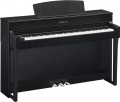Built-in timbres
The number of built-in sounds provided by the Digital Piano.
Despite the name, digital pianos are extremely rarely designed to imitate the sound of only a piano — the electronic hardware allows them to provide other timbres of sound. In addition, even the piano has its own varieties — for example, among the grand pianos there are 6 main classes, from large concert to miniature. So the built-in sounds can cover different kinds of pianos, as well as other instruments and sound effects.
The abundance and variety of timbres in digital pianos as a whole is not as great as in synthesizers, however, in this category there are very “charged” models, with a hundred timbres or more (in the most multifunctional, this number can exceed 900). However, it is worth specifically looking for a “multi-instrumental” model if you do not intend to be limited to the sound of the piano and would like to have more freedom of choice. It is worth remembering that a specific set of timbres can be different.
If the instrument is bought exclusively as a piano, then here, on the contrary, it is worth paying attention primarily to solutions with a small number of timbres. Such models are not only cheaper than "universals" — they can also sound better (due to the fact that there are few timbres and the manufacturer can carefully approach the sound quality of each built-in "instrument").
More features
Additional features and sound customization options provided by the instrument in addition to those listed above. In this paragraph, usually, various original proprietary technologies and solutions are indicated; the specific meaning of these functions is best specified in the documentation for the tool.
Inputs
— Mini-jack (linear). Any
line input is designed to receive an audio signal in analogue format. Such an audio signal can be played back by the instrument itself through the built-in speakers, external speakers or headphones, switched to external equipment (for example, an amplifier or audio receiver), or recorded (if you have a sequencer, see above). In digital pianos, the most popular is the first option — playback; typically, the line-in sound either serves as an accompaniment to the main part or provides additional effects. As for the mini-Jack standard, this is a miniature plug, also called "3.5 mm" and known to many as a standard audio jack on a smartphone, laptop or computer. However, this standard is also very popular in digital pianos — among external signal sources, mini-Jack plugs are generally more common than full-size Jacks.
— Jack (linear). Line input using a Jack type connector (aka "6.35 mm"). In terms of purpose, such an input does not differ from the mini-Jack type input described above. As for the connector, it is almost 2 times larger than the mini-Jack in diameter — however, given the dimensions of digital pianos, this cannot be called a serious drawback. At the same time, the Jack socket provides a better and more reliable connection, with less likelihood of interference. At the same time, for a number of reasons, this type of connector is used somewhat less frequently in digital pianos.
— MIDI in. An
...input that allows the Digital Piano to receive MIDI signals from external equipment. MIDI is a standard signal format in electronic musical instruments; such a signal (MIDI-event) is created for each keystroke and contains information about the note number, strength, speed and duration of pressing; these signals can then be recorded and/or played back in a specific tone. The ability to receive MIDI events from external devices can be useful, for example, when playing two keyboard instruments at once (to play all the music on one of them, with better sound quality), or to use the digital piano as an adapter for another instrument that does not having the desired tones. In addition, technically, a MIDI signal can be switched to other devices (see "Outputs — MIDI thru").
— USB to device (type A). USB connector that allows you to connect various external devices to the digital piano. However, most often the range of such devices is limited to "flash drives" and other drives. However, even this functionality can provide very extensive additional features: you can play backing melodies from a flash drive, update user timbres and auto-accompaniment styles (see above) or even instrument firmware, and copy materials recorded by a sequencer to a flash drive (or even write music directly). ), etc. Specific features in different models may be different, this point should be clarified separately.
— Card reader. A device for reading memory cards — usually, the popular SD format. By purpose, this function is similar to working with a USB flash drive (see above), adjusted for the fact that memory cards will be convenient primarily when exchanging data with a laptop — almost all modern laptops are equipped with card readers, which cannot be said about desktop PCs.Power consumption
The power consumed by the tool during normal operation.
The cost of electricity, as well as connection requirements, depend on this indicator. At the same time, we note that digital pianos require relatively little energy — even in the most powerful and advanced models, consumption usually does not exceed 60 watts. So in fact, power consumption data is required mainly for specific cases — for example, to calculate the total load when connecting a tool to an autonomous generator along with other devices. In addition, this information may be useful when assessing the power of the built-in speaker, for more information, see "Built-in acoustics".

